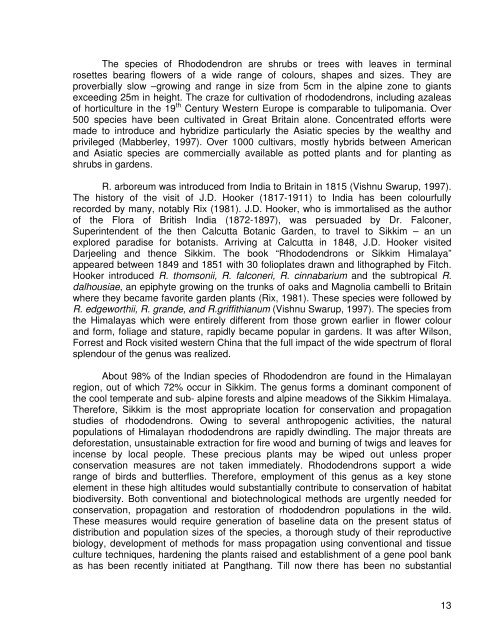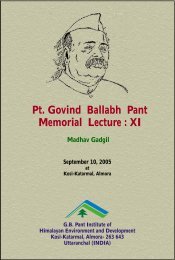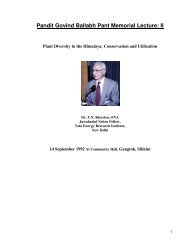Complete Lecture - Govind Ballabh Pant Institute of Himalayan ...
Complete Lecture - Govind Ballabh Pant Institute of Himalayan ...
Complete Lecture - Govind Ballabh Pant Institute of Himalayan ...
You also want an ePaper? Increase the reach of your titles
YUMPU automatically turns print PDFs into web optimized ePapers that Google loves.
The species <strong>of</strong> Rhododendron are shrubs or trees with leaves in terminalrosettes bearing flowers <strong>of</strong> a wide range <strong>of</strong> colours, shapes and sizes. They areproverbially slow –growing and range in size from 5cm in the alpine zone to giantsexceeding 25m in height. The craze for cultivation <strong>of</strong> rhododendrons, including azaleas<strong>of</strong> horticulture in the 19 th Century Western Europe is comparable to tulipomania. Over500 species have been cultivated in Great Britain alone. Concentrated efforts weremade to introduce and hybridize particularly the Asiatic species by the wealthy andprivileged (Mabberley, 1997). Over 1000 cultivars, mostly hybrids between Americanand Asiatic species are commercially available as potted plants and for planting asshrubs in gardens.R. arboreum was introduced from India to Britain in 1815 (Vishnu Swarup, 1997).The history <strong>of</strong> the visit <strong>of</strong> J.D. Hooker (1817-1911) to India has been colourfullyrecorded by many, notably Rix (1981). J.D. Hooker, who is immortalised as the author<strong>of</strong> the Flora <strong>of</strong> British India (1872-1897), was persuaded by Dr. Falconer,Superintendent <strong>of</strong> the then Calcutta Botanic Garden, to travel to Sikkim – an unexplored paradise for botanists. Arriving at Calcutta in 1848, J.D. Hooker visitedDarjeeling and thence Sikkim. The book “Rhododendrons or Sikkim Himalaya”appeared between 1849 and 1851 with 30 folioplates drawn and lithographed by Fitch.Hooker introduced R. thomsonii, R. falconeri, R. cinnabarium and the subtropical R.dalhousiae, an epiphyte growing on the trunks <strong>of</strong> oaks and Magnolia cambelli to Britainwhere they became favorite garden plants (Rix, 1981). These species were followed byR. edgeworthii, R. grande, and R.griffithianum (Vishnu Swarup, 1997). The species fromthe Himalayas which were entirely different from those grown earlier in flower colourand form, foliage and stature, rapidly became popular in gardens. It was after Wilson,Forrest and Rock visited western China that the full impact <strong>of</strong> the wide spectrum <strong>of</strong> floralsplendour <strong>of</strong> the genus was realized.About 98% <strong>of</strong> the Indian species <strong>of</strong> Rhododendron are found in the <strong>Himalayan</strong>region, out <strong>of</strong> which 72% occur in Sikkim. The genus forms a dominant component <strong>of</strong>the cool temperate and sub- alpine forests and alpine meadows <strong>of</strong> the Sikkim Himalaya.Therefore, Sikkim is the most appropriate location for conservation and propagationstudies <strong>of</strong> rhododendrons. Owing to several anthropogenic activities, the naturalpopulations <strong>of</strong> <strong>Himalayan</strong> rhododendrons are rapidly dwindling. The major threats aredeforestation, unsustainable extraction for fire wood and burning <strong>of</strong> twigs and leaves forincense by local people. These precious plants may be wiped out unless properconservation measures are not taken immediately. Rhododendrons support a widerange <strong>of</strong> birds and butterflies. Therefore, employment <strong>of</strong> this genus as a key stoneelement in these high altitudes would substantially contribute to conservation <strong>of</strong> habitatbiodiversity. Both conventional and biotechnological methods are urgently needed forconservation, propagation and restoration <strong>of</strong> rhododendron populations in the wild.These measures would require generation <strong>of</strong> baseline data on the present status <strong>of</strong>distribution and population sizes <strong>of</strong> the species, a thorough study <strong>of</strong> their reproductivebiology, development <strong>of</strong> methods for mass propagation using conventional and tissueculture techniques, hardening the plants raised and establishment <strong>of</strong> a gene pool bankas has been recently initiated at Pangthang. Till now there has been no substantial13











